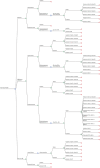A cost utility analysis for the management of acute exacerbations of chronic rhinosinusitis
- PMID: 39302214
- PMCID: PMC11785155
- DOI: 10.1002/alr.23452
A cost utility analysis for the management of acute exacerbations of chronic rhinosinusitis
Abstract
Background: The management of acute exacerbations of chronic rhinosinusitis (AECRS) is understudied and the most cost-effective management of AECRS has not been previously investigated. The aim of this study is to determine the most cost-effective strategy for the initial management of AECRS.
Methods: The study design consisted of a decision-tree economic model comparing three different initial strategies for managing a patient perceived AECRS: observation, upfront rescue medications, or clinic visit with diagnostic nasal endoscopy (DNE). The primary study outcome was the disease burden of a single AECRS, which was determined by the health utility value and the duration of symptoms. Strategies with an incremental cost-effectiveness ratio < $50,000/quality-adjusted life year (QALY) or equivalently < $137/quality-adjusted life day (QALD) were considered cost-effective.
Results: Observation was the most cost-effective strategy at a willingness to pay of $137 per QALD. One-way sensitivity analysis demonstrated that observation was more effective than upfront rescue medications when the probability of bacterial infection as the cause of AECRS was <24.0%. Upfront rescue medications wer more cost effective than observation when the probability of bacterial infection exceeded 49.0%. Clinic visit with DNE was the most effective strategy to manage an AECRS, but it was not considered cost-effective.
Conclusion: Observation is the most cost-effective strategy for the initial management of AECRS when there is a low likelihood of bacterial infection. When the probability of bacterial etiology of AECRS exceeds 49.0%, upfront rescue medications proved to be the most cost-effective strategy.
Keywords: AECRS; acute exacerbations; antibiotics; chronic rhinosinusitis; corticosteroids; cost‐effectiveness; management; treatment.
© 2024 The Author(s). International Forum of Allergy & Rhinology published by Wiley Periodicals LLC on behalf of American Academy of Otolaryngic Allergy and American Rhinologic Society.
Conflict of interest statement
The authors declare no financial disclosures or conflicts of interests relevant to this manuscript.
Figures
Similar articles
-
Economic evaluation of endoscopic sinus surgery versus continued medical therapy for refractory chronic rhinosinusitis.Laryngoscope. 2015 Jan;125(1):25-32. doi: 10.1002/lary.24916. Epub 2014 Sep 3. Laryngoscope. 2015. PMID: 25186499 Free PMC article.
-
Cost utility analysis of endoscopic sinus surgery for chronic rhinosinusitis.Int Forum Allergy Rhinol. 2016 Jun;6(6):582-9. doi: 10.1002/alr.21697. Epub 2016 Mar 17. Int Forum Allergy Rhinol. 2016. PMID: 26991813
-
Reciprocal Predictive Accuracy of Sinonasal Symptom Severity, Nasal Endoscopy, and Frequency of Past Chronic Rhinosinusitis Exacerbations.Otolaryngol Head Neck Surg. 2018 Oct;159(4):766-773. doi: 10.1177/0194599818774741. Epub 2018 May 15. Otolaryngol Head Neck Surg. 2018. PMID: 29759028
-
Acute exacerbations of chronic rhinosinusitis: The current state of knowledge.Laryngoscope Investig Otolaryngol. 2022 Jul 20;7(4):935-942. doi: 10.1002/lio2.857. eCollection 2022 Aug. Laryngoscope Investig Otolaryngol. 2022. PMID: 36000029 Free PMC article. Review.
-
Treatment modalities for bacterial rhinosinusitis.Expert Opin Pharmacother. 2010 Apr;11(5):755-69. doi: 10.1517/14656561003598901. Expert Opin Pharmacother. 2010. PMID: 20201730 Review.
References
MeSH terms
LinkOut - more resources
Full Text Sources
Medical


